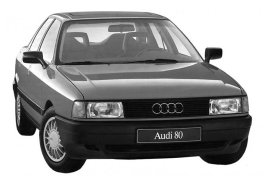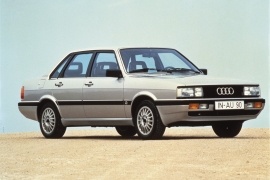AUDI 80/ 90 Models/Series Timeline, Specifications & Photos
First production year: 1984
Engines: Gasoline, Diesel
Audi introduced the third generation of the 80 in 1986, and it was a completely new, rounded design, which was totally opposite to the previous model, which was wedge-shaped.
The German automaker started its way up into the premium segment offering a different approach than its main competitors, BMW and Mercedes-Benz. Since it featured front-wheel and all-wheel drive platforms, it offered a safer alternative for those afraid of driving an RWD vehicle, especially on slippery surfaces. Still, its cabins and materials were behind what other premium carmakers had to offer, but it was narrowing the gap. With the 80 lineup, Audi also introduced fully galvanized bodywork, which was far more resistant to rust, a problem that was yet to be solved by its rivals.
With its shaved edges and curved body panels, the 80 was way above other cars on the market in terms of design. Still, its headlights remained rectangular, but with the blinkers mounted on the corners. The plastic bumper incorporated the lower apron that was fitted with a secondary grille and, as an option, fog lamps. From its profile, the greenhouse sported a third side window behind the rear doors, improving the driver's visibility and the cabin's luminosity. At the back, the wide taillights were stretched from the quarter panels onto the trunk lid, creating the image of a more luxurious vehicle.
Inside, the materials' quality was above average and, depending on the options, fit for e premium vehicle. While the base models featured cranked windows and cloth upholstery, the upper trim levels were available with power windows and locks and leather seats.
Under the hood, Audi installed a wide choice of gasoline and turbo-diesel engines, depending on the market.
Audi was not yet considered a premium carmaker back in the mid-'80s when it introduced the facelifted version of the 80, but it did a marketing stunt that worked.
The German carmaker struggled hard to catch its main German rivals BMW and Mercedes-Benz. Its advantage was slim since most customers were stuck with the idea that a premium car had to have a rear-wheel-drive system. Audi came with the Quattro all-wheel-drive system, which proved to be a better idea, especially on loose surfaces. It already proved its value in rally-racing, but it was not a regular feature on production vehicles. The carmaker already had the 80 model, but that was not a serious contender for the BMW 3-Series or 190 E.
After the facelift, the 90 became easier to recognize than its 80 sibling. It sported a specific front fascia with two rectangular headlamps and a wrapped-around plastic bumper that featured standard parking and fog lights. At the back, the car featured larger taillights, which resembled those installed on the 100 model.
Inside, the carmaker installed a rectangular-shaped instrument cluster inspired by the Audi Quattro Coupe. Its center stack featured the climate controls above the stereo-cassette player and under the dual center vents. Its sport bucket seats featured bolstered areas. It was a sport sedan, and it wasn't afraid to show it.
Audi installed under the 90's hood only inline-five engines, resembling the one installed in the rally car. The top-spec version featured a turbocharged unit, while Mercedes-Benz and BMW were still relying on their naturally aspirated powerplants.

